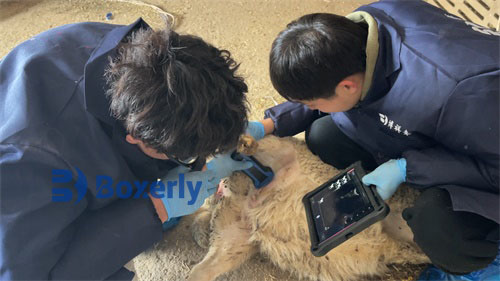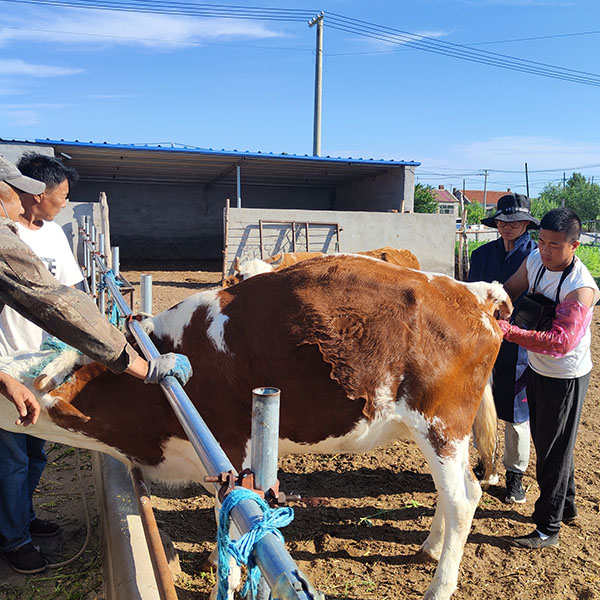Ultrasonic imaging diagnosis technology uses pulsed current to cause the ultrasonic probe to emit multi-beam ultrasonic waves. The reflected sound waves during detection on the cross section can be converted into pulsed current signals by the probe, forming light spots of different brightness on the screen to display the cross-sectional images of the detected part. We use the advantages of this instrument, which is fast, intuitive, accurate and non-destructive, to observe the development of the ovaries, follicles and corpora lutea of the donor and recipient cows of dairy cow embryo transplantation and record them in images. By monitoring the ovaries and identifying the effects of synchronous estrus and superovulation, the success rate of embryo transplantation can be improved.
B-ultrasound detection method for imported cattle
Select the cows for imported cattle B-ultrasound detection 1d before synchronous estrus, 2, 3, 4, 5, 6d after estrus, 1, 3d after superovulation and on the day of embryo flushing, mainly to detect the size and shape of the ovaries, follicles and corpora lutea.
For Baoding dairy cows, first remove the rectal feces, palpate the ovaries, obtain preliminary positioning, then manually insert the disinfected and moistened probe into the rectum, and after reaching the ovarian position, fix the ovary with your fingers, and gently stick the probe to the free edge of the ovary through the rectal wall for inspection. When the typical image of the ovary, follicle or corpus luteum appears on the screen, freeze the image, measure the longitudinal and transverse diameters of the ovary, follicle or corpus luteum with an electronic ruler, and print it with an image printer or take a photo with a digital camera; scan it with a scanner or directly input it into a computer for storage and processing.
Changes in follicle ultrasound images
The follicles grow slowly during the synchronous estrus, with the maximum diameter increasing from 8.31±0.6mm on the 2nd day to 13.5±2.1mm on the 5th day, but decreasing to 12.1±2.9mm on the 6th day. The follicles grow faster during the superovulation period, with the maximum diameter increasing from 14.5±2.0mm on the 10th day to 20.3±4.6mm on the 12th day, with an average growth rate of 1.9mm/d. The follicle diameter is the largest on the 12th day, at 21.8-18.2mm, 3-4 times that of the synchronous estrus.
The follicle wall has almost no change during the synchronous estrus period, but rapidly thins during the superovulation period, with the thinnest reaching 2mm. In addition, the boundary between the follicle wall and the surrounding ovarian tissue becomes clearer, and the echo contrast reaches the strongest. The follicles have various shapes during the synchronous estrus period. Most of them are oblong or round, and a few are triangular. On the third day of superovulation, they remain round, and a few are oblong.








